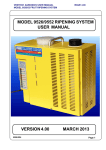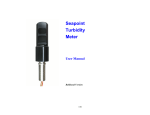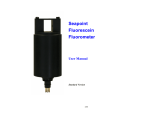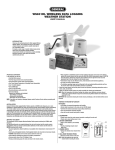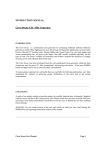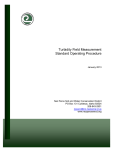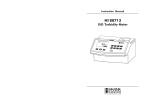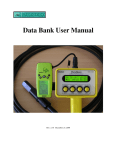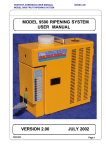Download Seapoint Turbidity Meter
Transcript
Seapoint Turbidity Meter User Manual 07/2013 Dimensions 1.00" (25.4mm) 1.00" (25.4mm) 2.62" (66.5mm) 2.22" (56.4mm) Connector versions Bulkhead version Figure 1. Outline Drawing 7/29/2013 2 Specifications • • • • • • • • • • • • • • • • Power Requirements: 7-20VDC, 3.5mA avg, 6mA pk Output: 0-5.0 VDC Output Impedence: 1000 ohms Output Time Constant: 0.1 sec RMS Noise: < 1 mV Power-up Transient Period: <1 sec Light Source Wavelength: 880 nm Scattering Angles: 15 - 150 degrees (approx. 90 degree peak sensitivity) Linearity: ±2 % 0-1250 FTU, ±5% 0-1600 NTU Sensitivity/Range: 100x gain: 200 mV/FTU 25 FTU 20x gain: 40 mV/FTU 125 FTU 5x gain: 10 mV/FTU 500 FTU 1x gain: 2 mV/FTU 4000 FTU * * response above 1250 FTU becomes non-linear Temperature Coefficient: < 0.05 %/°C Operating Temperature: 0°C to 65°C Depth Capability: 6000 m (19,700 ft) Sensor Weight (dry): 80 g (3 oz) Body Diameter: 2.5 cm (1.0 in) Materials: Rigid polyurethane plastic and epoxy 7/29/2013 3 Introduction The Seapoint Turbidity Meter is a sensor that measures turbidity by detecting scattered light from suspended particles in water. Its small size, very low power consumption, high sensitivity, wide dynamic range, and 6000 meter depth capability allow this sensor to be used in most applications where turbidity or suspended particle concentrations are to be measured. The sensor is also insensitive to ambient light when under water and has a very low temperature coefficient. The Seapoint Turbidity Meter senses scattered light from a small volume within 5 centimeters of the sensor windows. Confining the sensing volume allows the sensor to be calibrated in relatively small water containers without errors from surface and wall reflections. It also allows the sensor to be used in tight spaces such as crowded instrumentation packages, pipes, and shallow streams. Two control lines allow the user to externally set the sensitivity of the Seapoint Turbidity Meter by choosing one of four gains. This provides an easy means to set the sensitivity to provide the range and resolution required for a particular application. Sensitivities of 2, 10, 40 and 200 mV/FTU are possible. Each sensor is factory adjusted for consistent response to Formazin Turbidity Standard measured in Formazin Turbidity Units (FTU). The user may also calibrate the sensor with particles of interest to measure suspended solids concentrations. The Seapoint Turbidity Meter is constructed of rugged, corrosion resistant materials and quality surface mount electronic components for durability and high reliability. 7/29/2013 4 Optical Design Sensing Volume LED Photodiode Figure 2. Diagram of Seapoint Turbidity Meter Optics Figure 2 shows a cross-section of the Seapoint Turbidity Meter optics. The light sources are side-by-side 880 nm Light Emitting Diodes (LEDs). The light detectors are side-by-side silicon photodiodes. The LEDs are extremely efficient and well matched to the peak sensitivity of the silicon photodiodes. The opaque housing forms a light block which prevents light from the emitter from reaching the detector directly. Light from the LEDs shines through the clear epoxy emitter window into the sensing volume where it is scattered by particles. It is possible for light scattered at angles between 15 and 150 degrees to enter the detector’s receiving cone and reach the photodiodes. The amount of scattered light that reaches the detectors is proportional to the turbidity or particle concentration in the water over a very large range. The optical design of the Seapoint Turbidity Meter is unique in its restriction of the angle of emission of the light sources and the 7/29/2013 5 angle of detection of the light detectors. This confines the sensing volume to within five centimeters of the sensor windows. The advantage of confining the sensing volume to a small space near the sensor is the great reduction of interference from reflections from large objects outside the sensing volume. This allows the sensor to be calibrated in a relatively small water container without interference from surface or wall reflections. It also allows the sensor to be used where limited volume of water exists for sensing or in the midst of objects that would otherwise cause interfering reflections. Examples include instrumentation packages with limited space between instruments or limited space inside the frame, monitoring water inside pipes, and measuring water in shallow streams or very close to the bed of a water body. 7/29/2013 6 Electronic Design The Seapoint Turbidity Meter has an electronic design that achieves high sensitivity while consuming very little power. Micropower components are used so that most of the power drawn by the sensor is used to drive the LEDs. Overall power requirements are 7-20 VDC, 3.5 mA average, 6 mA peak. Optical feedback is used in the light source drive circuitry. This offers several benefits including excellent temperature compensation for the optical components, compensation for the aging of the optical components, and stable output within a second after power up. The light source is modulated, and synchronous detection is used to extract the scattering signal from the overall signal, removing the ambient light component and most of the electronic noise. Achieving high sensitivity using low power was accomplished by paying careful attention to proper circuit board layout to prevent any stray coupling of signals synchronous with the modulation of the light source into the detection circuitry. The need for offset adjustment was thereby eliminated — the offset voltage for this sensor at any gain is within one millivolt of zero. 7/29/2013 7 Operation The Seapoint Turbidity Meter requires 7 to 20 VDC input and will draw an average of 3.5 mA current with a peak current draw of 6 mA. Output is 0 to 5.0 VDC with a 0.1 second time constant. Warning: Applying voltages to the output pin or powering the sensor with a voltage greater than 20 V will result in damage to the sensor. Connector versions should be cleaned and lubricated with 3M Silicone Spray, Dow Corning #111 Valve Lubricant or equivalent prior to connecting. Bulkhead versions should have the bulkhead (connector end of sensor) and the mating machined housing cleaned and lubricated with an o-ring lubricant. A mechanical drawing for the machined housing accepting the bulkhead version is shown in Figure 3. o-rings 1.5 1/2-20 0.28 0.500 0.562+.002 -.000 Figure 3. Drawing of bulkhead sensorand customer housing. 7/29/2013 8 Pinouts (connector versions) and wire color code (bulkhead versions) for the Seapoint Turbidity Meter are as follows: Pin # (connector versions) Pin 1 Pin 2 Pin 3 Pin 4 Pin 5 Pin 6 Wire color (bulkead versions) Brown Blue Green Yellow Orange Red Gain Function Power Ground Signal Output (0-5VDC) Signal Ground Power In (7-20VDC) Gain Control A Control B Table 1. Seapoint Turbidity Meter connections The two independent gain control lines A and B are used to select one of four possible gain settings (see Table 2). These wires can be hardwired for the desired gain or interfaced with a microprocessor, using 5 volt logic, to allow gain to be controlled through software. Hardwiring the gain does not require an external voltage source. To hardwire a line to +5V, simply leave it open, which allows an internal pull-up to hold it at +5 VDC. To set a line to 0V, tie it to the power ground. n/a 2 mV/FTU (<750 FTU) A +5 V +5 V 0V 0V B +5 V 0V +5 V 0V Gain 100X 20X 5X 1X Sensitivity 200 mV/FTU 40 mV/FTU 10 mV/FTU 2 mV/FTU Range 25 FTU 125 FTU 500 FTU 4000 FTU* * response becomes nonlinear above 1250 FTU Table 2. Truth Table for Switching Gains The sensor linearity in Formazin is ±2 % at the 100X, 20X, and 5X gain settings. The 1X gain setting is used in extremely turbid water. The sensor response above 1250 FTU becomes nonlinear; however, the useful range can be extended by calibrating the sensor and fitting the response with a second order 7/29/2013 9 polynomial equation. This approach is limited by the increasingly flat response at turbidity levels approaching 4000 FTU. Figure 4 shows a typical sensor response. Sensor Output (Volts) 10 1 100X 0.1 20X 5X 0.01 0.001 0.01 1X 0.1 1 10 100 1000 10000 Sensor Output (Volts) Turbidity (FTU) 5 4.5 4 3.5 3 2.5 2 1.5 1 0.5 0 1X 0 1000 2000 3000 4000 Turbidity (FTU) Figure 4. Sensor Response to Formazin Turbidity Standard 7/29/2013 10 Calibration All sensors are adjusted to the nominal sensitivities specified so that for most purposes they are interchangeable. If greater accuracy is desired, it is recommended that the user perform calibrations on individual sensors. The sensors can also be calibrated by the user to measure suspended solids concentrations. Like other optical turbidity sensors, this calibration must be performed using a sample from the measurement site. Calibrations with different particle types will typically result in different values for sensitivity (V/(mg/l)). Calibrations should be performed periodically at a frequency which depends on the condition of the windows. Although these sensors are electronically stable with time, scratching or fouling of the windows will result in reduced sensitivity. Visual inspection is a good test of whether the sensor needs recalibration: if the windows appear polished and clear when dry, the sensitivity probably has not degraded significantly. When calibrating in a small container, multiple scattering events may reflect off the container walls introducing a small error to the calibration. For this reason, the use of a black container is recommended. Calibration should be performed under fluorescent or LED lighting. Incandescent lights emit large amounts of energy at the operating wavelength which may interfere with measurements. 7/29/2013 11 Care The Seapoint Turbidity Meter is a rugged instrument that should provide years of reliable performance with minimal care. After using, rinse the sensors and clean the windows with water and mild detergent if necessary (avoid using organic solvents). If windows become scratched, they may be polished using a cloth buffing wheel with polishing compound. The connectors should be lubricated before each use with 3M silicone Spray, Dow Corning #111 Valve Lubricant or equivalent. The Seapoint Turbidity Meter contains no user serviceable electronics and must be returned to the factory if it does not operate properly. Limited Warranty Seapoint Sensors, Inc. warrants this Turbidity Meter to be free of defects of materials and workmanship under normal use and service for a period of 1 year from the date of shipment. This warranty extends only to the original purchaser. In the event the product fails to operate according to our published specifications during the warranty period, Seapoint Sensors, Inc. will repair or replace the instrument at our discretion. If it is determined that the failure was due to other than normal use or service, repairs will be billed and estimate will be submitted prior to repair work. Shipping costs must be prepaid. Seapoint Sensors, Inc. accepts no responsibility for damage during return shipment. 7/29/2013 12 Seapoint Sensors, Inc. P.O. Box 368 Exeter, NH 03833 USA 7/29/2013 Tel:503-642-4921 [email protected] www.seapoint.com 13













